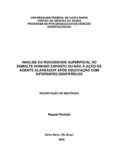| dc.creator | Pachaly, Raquel | |
| dc.date.accessioned | 2010-02-10 | |
| dc.date.available | 2010-02-10 | |
| dc.date.issued | 2009-12-16 | |
| dc.identifier.citation | PACHALY, Raquel. ANALYSIS OF SURFACE ROUGHNESS OF THE HUMAN ENAMEL
EXPOSED OR NOT THE ACTION OF BLEACHING AGENT AFTER
BRUSHING WITH DIFFERENT DENTIFRICES. 2009. 87 f. Dissertação (Mestrado em Odontologia) - Universidade Federal de Santa Maria, Santa Maria, 2009. | por |
| dc.identifier.uri | http://repositorio.ufsm.br/handle/1/6055 | |
| dc.description.abstract | The aim this study was to evaluate, in vitro, the average surface roughness (Ra) of human enamel exposed or not to the action of bleaching agent with carbamide peroxide (CP) 10% after brushing with different dentifrices. Ninety-six (96) specimen enamel was used and divided into two groups: GI- exposed to the action of bleaching agent and GII- non exposed to the action of bleaching agent and subdivided into eight subgroups of brushing: (CEW) Close-Up Extra Whitening, (CUB) Colgate Ultra White (CPC) Crest Cavity Protection and (DW) deionized water. The specimens from the GI group were submitted to the bleaching treatment with
PC10% for 6h during14 days; the GII group were stored in artificial saliva for 14 days. After this period the groups were subjected to 35,600 cycles in the mechanical
toothbrushing machine equivalent to 2 years and a half of the normal brushing, using the Oral-B toothbrush. The Ra was measured before and after brushing with Mitutoyo
SJ 201P perfilometer. The results were submitted to ANOVA and Tukey test (5%) and indicated that there is not significant difference in Ra between GI and GII.
Among the subgroups of brushing, it might be observed a significant increase of the roughness for the CEW subgroup with statistical difference for the CUB subgroup.
The subgroups CCP and DW presented intermediate values of Ra not differing from the other subgroups of brushing. These results are related to different abrasives
which are present in the composition of dentifrice once the abrasiveness of the dentifrice depend particle hardness, shape, size, size distribution and concentration. | eng |
| dc.format | application/pdf | por |
| dc.language | por | por |
| dc.publisher | Universidade Federal de Santa Maria | por |
| dc.rights | Acesso Aberto | por |
| dc.subject | Dentifrícios | por |
| dc.subject | Clareamento dental | por |
| dc.subject | Rugosidade | por |
| dc.subject | Dentrifices | eng |
| dc.subject | Bleaching teeth | eng |
| dc.subject | Roughness | eng |
| dc.title | Análise da rugosidade superficial do esmalte humano
exposto ou não à ação de agente clareador após
escovação com diferentes dentifrícios | por |
| dc.title.alternative | Analysis of surface roughness of the human enamel
exposed or not the action of bleaching agent after
brushing with different dentifrices | eng |
| dc.type | Dissertação | por |
| dc.description.resumo | O objetivo deste trabalho foi avaliar in vitro a rugosidade superficial média (Ra) do esmalte humano exposto ou não à ação de agente clareador com peróxido de carbamida (PC)10% após escovação com diferentes dentifrícios. Foram utilizados 96 espécimes de esmalte divididos em 2 grupos: GI- exposto à ação de gel clareador e GII- não exposto à ação de gel clareador e subdivididos em 8 subgrupos de escovação: (CEW) Close-Up Extra Whitening, (CUB) Colgate Ultra
Branco, (CCP) Crest Cavity Protection e (AD) Água Deionizada. Os espécimes do grupo GI foram submetidos ao tratamento clareador com PC10% por 6h/14 dias; os
do grupo GII ficaram armazenados em saliva artificial por 14 dias. Decorrido este período, os grupos foram submetidos à 35.600 ciclos em máquina de escovação mecânica que corresponde a 2 anos e meio de escovação normal, utilizando escova Oral-B. A Ra foi medida antes e depois da escovação com um Rugosímetro Mitutoyo SJ 201P. Os resultados foram submetidos à ANOVA e ao Teste de Tukey (5%) e indicaram que não existe diferença significativa de Ra entre os grupos GI e GII. Entre os subgrupos de escovação pode-se observar um aumento significativo da rugosidade para o subgrupo CEW com diferença estatística para o subgrupo CUB. Os subgrupos CCP e AD apresentaram valores intermediários de Ra, não diferindo dos demais subgrupos de escovação. Esses resultados estão relacionados com os diferentes abrasivos presentes na composição dos dentifrícios uma vez que a
abrasividade do dentifrício depende da dureza, forma, tamanho, amplitude da distribuição e concentração das partículas. | por |
| dc.contributor.advisor1 | Pozzobon, Roselaine Terezinha | |
| dc.contributor.advisor1Lattes | http://buscatextual.cnpq.br/buscatextual/visualizacv.do?id=K4773209Z9 | por |
| dc.contributor.referee1 | Andrada, Mauro Amaral Caldeira de | |
| dc.contributor.referee1Lattes | http://buscatextual.cnpq.br/buscatextual/visualizacv.do?id=K4783048Z6 | por |
| dc.contributor.referee2 | Susin, Alexandre Henrique | |
| dc.contributor.referee2Lattes | http://buscatextual.cnpq.br/buscatextual/visualizacv.do?id=K4700480Y9 | por |
| dc.creator.Lattes | http://buscatextual.cnpq.br/buscatextual/visualizacv.do?id=K4277847J6 | por |
| dc.publisher.country | BR | por |
| dc.publisher.department | Odontologia | por |
| dc.publisher.initials | UFSM | por |
| dc.publisher.program | Programa de Pós-Graduação em Ciências Odontológicas | por |
| dc.subject.cnpq | CNPQ::CIENCIAS DA SAUDE::ODONTOLOGIA | por |


